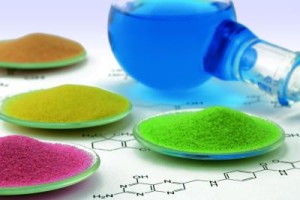
Dyes and pigments are two kinds of colorants that have found their way into every aspect of our lives. As far as the industrial sector is concerned, several types of dyes and pigments are being used in large amounts in a series of applications. Dyes are soluble substances which have an affinity towards the substrate and the industries which find use for them are leather, textile, cement, plastic, paper industry and many more. Pigments on the other hand are insoluble substances and are available in granular or powder form. Their mode of imparting colour is through the reflection of specific light rays. The industries where pigments find maximum use are the inks and paint industry.
Some of the dyes used in industrial applications are listed below:
- Leather Dyes: Different types of leather dyes are used by tanneries depending upon the effect desired by them on the leather products. Some of the dyes used here include the basic, direct, mordant, acid and reactive dyes.
- Digital Textile Printing Dyes: Charged drums or ink-jet nozzles controlled by computers are the medium through which digital printing takes place. Digital prints can be replicated on normal paper, plastic, photographic paper, cloth etc. The dyes that are normally used in this category are dye based inks; disperse inks, acid inks and reactive inks.
- Sublimation Dyes: These dyes are mainly used in varied forms of printing like in inkjet inks, laser print toners, ribbons for thermal transfer and so on. The process of heat transfer is involved in the application of these dyes. The major varieties of dyes involved here are disperse, direct, reactive, vat and acid dyes.
Coming to pigments, the types of pigments that find their way into industrial applications are:
- CLC Pigments: Made from CLC films, Cholesteric Liquid Crystal pigments find their use mainly in security machines. They act as deterrents to production of counterfeit legal documents, currency notes etc.
- Fluorescent Pigments: One of the major features of this type of pigments is the ability to change ultraviolet light into the required colour. They are therefore greatly used in all types of fluorescent items. Industries that find use for this type of pigment are textile, paints and aerosol coating and solvent based paper coating industries.
- Ultramarine Pigments: One of the earliest varieties of pigments, ultramarine pigments are a type of inorganic pigments that are non-irritating and non-toxic in nature. Ultramarine pigments are increasingly used in colouring, coating, cosmetics, printing inks and the artist’s palette. The two basic types in this category are ultramarine violet and ultramarine blue.
- Organic Pigments: This type of pigments comes in the form of solid particles which are not soluble in the application medium. The two main pigment types here are synthetic and natural pigments. Around 25% of all synthetic organic pigments are phthalocyanine derivatives. Some of the phthalocyanine pigments like phthalocyanine blue is used in dyes and paints; phthalocyanine green is used in coatings, inks, plastics etc. Organic pigments are all in all used for coating and colouring on paper, plastics, candles, pharmaceuticals, rubber materials etc.
Pigments and dyes have indeed added a great deal of colour to the industrial world!